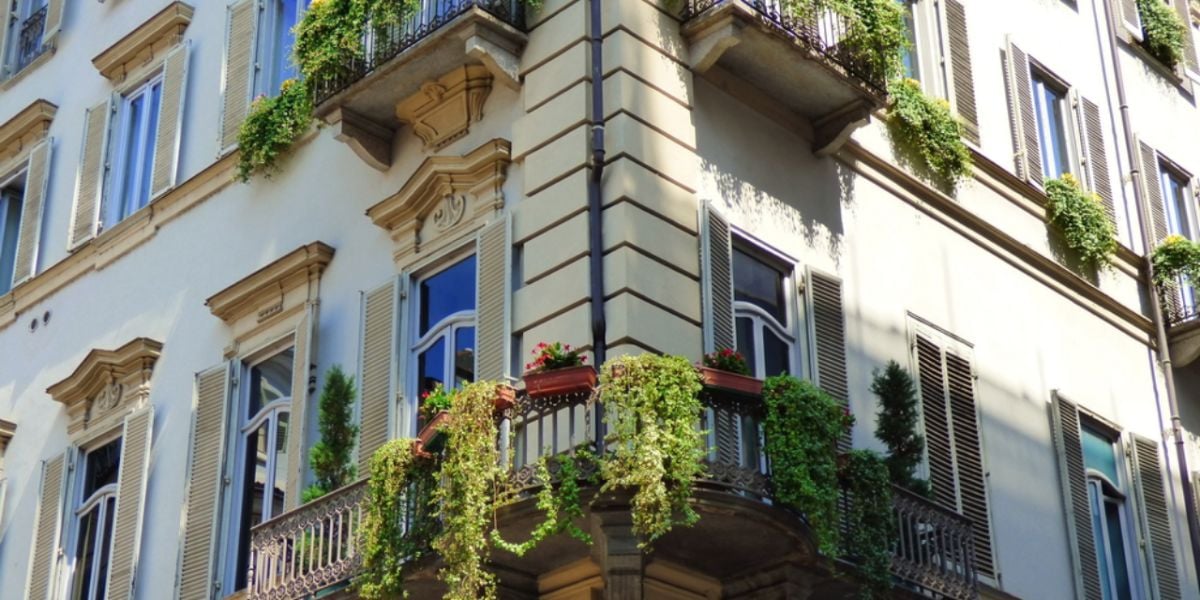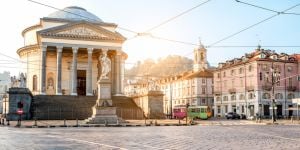
Located at the foot of the Alps, Turin is a city renowned for design, innovation and a remarkable combination of industry, gastronomy, and the promotion of arts and culture. The former capital of Italy used to be the seat of the Italian monarchy and is now home to some impressive architectural masterpieces. If you plan to relocate to Turin, you will not be disappointed by the range of properties the city offers. In this article, we will give you some valuable tips and information about finding accommodation in Turin.
Turin is an impressive city with its geometric and orderly street layout, often lined with elegant porticoes. The symmetry of its monumental squares, the homogeneity of its architecture and the regularity of its long avenues make it a stunning city. It is smaller and certainly less expensive in terms of property rentals than Rome or Milan, making it a popular destination for expatriates, whether you are moving alone or with your family. In addition, its location offers great views of the Alps and access to outdoor activities, making it a good starting point for, say, a winter holiday. Find a more in-depth presentation of the city in our article "Leisure activities in Turin".
The real estate market in Turin
According to a study carried out in November 2022 by Idealista, a leading real estate portal, the price of a square meter in Turin would be, on average €9.4 (a 12% rise compared to 2021), with differences depending on the area, such as the historical center where the average price is €12.4/sqm.
According to the Idealista study, the average price per square meter for sale in the city is €1,832 per square meter (a 2.4% rise compared to 2021), again with variations depending on the area you wish to buy in, with prices in the historic center reaching €3,400 per square meter.
Types of accommodation in Turin
Most of the accommodation in Turin is in buildings called palazzi, which are generally signorili, elegant buildings. Some may have balconies or small terraces and sometimes have lifts. As for rents, of course, they tend to fall as you move away from the city center.
The flats and studios you can find in Turin, as in the rest of Italy, are the following:
- Monolocale: studio apartment (from 25 - 40 m²)
- Bilocale: two-room flat (from 50 - 60 m²), including one bedroom
- Trilocale: three-room flat (from 80 m²), including two bedrooms
- Quadrilocal: four-room flat (from 100 - 120 m²), including three bedrooms
- Attico: penthouse with a terrace, usually of large dimensions
Important:
The Turin property market has its own habits, as is the case with the rest of Italy. For example, in some advertisements, you can see flats for rent completely furnished (arredato): dining room furniture, beds, wardrobes, etc.) or even semi-furnished (semi-arredato). In addition, when selling a flat, the owners may take back the kitchen and bathroom furniture (including appliances). In this case, you will have to buy them in addition to the property for sale if you wish to keep them.
Pay attention to the calculation of square meters in Italy, as this differs depending on whether we are talking about living space or commercial space. Commercial space takes into account any balconies, cellars, etc., and therefore non-habitable spaces. If you have any doubts, feel free to ask your questions to the estate agent and/or the owner when you visit a property.
The districts of Turin
The city of Turin is divided into five distinct areas, each with its own municipality: Municipio 1, Municipio 2, Municipio 3, Municipio 4 and Municipio 5. These municipalities differ, some being more industrial. In contrast, others are more commercial or residential. As in Milan, prices vary according to criteria such as distance from the historical center, the prestige of the buildings, surface area, condition of the accommodation, and the presence of public transport.
Municipio 1 consists of the districts of Cenisia, Centro, Crocetta, San Secondo, San Teresina, Pozzo Strada and San Paolo.
Municipio 2 consists of Castello di Mirafiori, Mirafiori Nord, Mirafiori Sud and Santa Rita.
Municipio 3 consists of Borgo Po, Cavoretto, Lingotto, Nizza, Millefonti and San Salvario.
Municipio 4 consists of Barriera di Milano, Regio Parco, Valdocco, Aurora, Rossini, Madonna del Pilone, Oltre Stura, Vanchiglia and Vanchiglietta.
Municipio 5 consists of Borgo Vittoria, Lucento, Vallette, Madonna di Campagna, Parrella, San Donato, and Campidoglio.
The most popular areas of Turin
If you are looking for a rental flat or house for your stay in Turin, you should know that, as in most Italian cities, there are some areas that are trendy and others that are more popular with families. Here are the most popular areas to find accommodation in Turin:
Centro storico: the historic center district contains most of the city's historical and cultural wealth and is home to beautiful, elegant buildings and endless porticos. Here you will find, for example, Piazza Castello and the Royal Museums, via Roma, via Po, Piazza Vittorio Veneto, the Museum of Egyptian Antiquities but also the Mole Antonelliana and the famous Cinema Museum. The center is full of pretty little hidden courtyards, well-tended gardens and plenty of opportunities to wander around and discover historic shops, workshops, cafés and chocolatiers. There is a wide range of real estate on offer, and unlike in Milan, prices are still quite affordable.
Crocetta: this prestigious area is located just south of the historic center and is considered one of the most beautiful in Turin. It is made up of elegant liberty-style buildings, mansions, tree-lined avenues, offices and luxury shops. It is usually home to penthouses that offer a beautiful view of the city's hills. This area is also home to the Polytechnic University, one of the best in the country.
Roma: this is an area in the center, west of the Palazzo Reale, which was built on the ancient Roman city. It has a network of small streets, porticos, and small squares with hidden churches. The area is quiet during the day and comes alive in the evening at aperitif time with its many bars and restaurants.
Campidoglio: this exciting and fashionable area is also ideal for families. It is located to the northwest of the center and is made up of renovated residential buildings, small houses and streets and alleys that make it look like a village at times. It is well-served by public transport, especially the metro, which makes it easy to reach the center.
Cenisia: This district with an industrial past is now a very interesting area. There are museums such as the GAM (Gallery of Modern Art) but also the Officine Grandi Riparazioni, a center of cultural and technological innovation that housed a railway factory in the 19th century. It is also an area of choice for families and students as it is close to Crocetta, where the Polytechnic is located.
San Salvario: for those who like lively neighborhoods, this area of Turin is the most lively in the city. Multi-ethnic, popular and colorful, it is lively day and night with its many bars and restaurants. The area is both close to the train station and the city center. It is the ideal area to share a flat with friends, for example. There is a much quieter part of the area near the Parco del Valentino.
Borgo Crimea and Borgo Po: for those who want to live in a quieter, greener area but still be close to the center, there is a part of Turin that lies to the right of the river Po, to the east on the city map. First, there is Borgo Crimea, a residential area that is among the most exclusive parts of the city, quiet, with large and elegant flats. There are few, if any, high-end shops and historic buildings. Then, moving away from the river, you arrive at Borgo Po, a green hilly area with villas, small buildings with luxury flats, parks, sports circles, elegant restaurants and bars. These two areas are among the most expensive in the city. There is also the Villa della Regina, a 17th-century palace intended by the former Italian royal family, the Savoia. It is one of a group of 13 historical buildings listed as Unesco heritage sites.
Good to know:
On average, unlike Rome or Milan, Turin is still a city where you can choose your neighborhood according to your desires, the city being on a human scale and offering relatively accessible prices. However, the pedestrian areas of the historic center are not always ideal for driving or parking unless you have a parking space or a resident's pass. Indeed, many Limited Traffic Zones (LTZ) have been established, and entry will cost you €50 per year plus €16 in tax stamps.
Finding accommodation in Turin
As you would for any other city in the country, start your search for accommodation in Turin online. Housing websites such as Immobiliare, Idealista et Casa.it, or Trovacasa are ideal starting points.
If you are an international student looking for a flat, studio, flat or room in Turin, check with your institution to see if they have accommodation available or use a database such as the Erasmus database. Room and flat sharing between students are widespread in Italy. Use a search tool such as Dotstay, Roomtastic, or Uniaffitti to find a list of available rooms.
You can also use the services of a real estate agency if you are having trouble finding a home in Turin. They will be able to offer you properties before or as soon as they come on the market. FondoCasa, Sintedil Agency SRL, Nova Investimenti Immobiliari and Grande Immobiliare are among the leading real estate agencies in Turin. There are also groups such as Remax, Gabetti and Tecnocasa. Please note that if you use an estate agency to find a property in Turin as a tenant, you will have to pay a fee for the service provided.
Renting accommodation in Turin
Generally, rental agreements in Italy are valid for a minimum of four years, but it is possible to obtain shorter-term contracts. Note that these are usually more expensive.
Here are some examples of the most common rental contracts in Turin, which are common throughout Italy:
- Contratto a canone libero, a four-year contract that you can renew. It is also called in Italian the 4 4 contract. It is possible to terminate it, but you will have to inform the owner, agree on the date of your departure, and above all, respect the length of the notice period. Note that some landlords are more tolerant than others, allowing you to stay a little longer or a little shorter, depending on your needs. However, the landlord may ask you to accept visits in order to re-let the property.
- Contratto di affitto a canone concordato is a contract that allows you to fix the rent in a predefined economic bracket that depends on the type of building or flat or the facilities and services provided (lift, garage, etc.). These bands are set by the region and/or the municipality, but in order to benefit from this contract, it is necessary to have the agreement of the owner and to define the band that applies to the property you wish to rent.
- Contratto di affitto convenzionato is a three-year contract between the tenant and the owner that is automatically renewed for two years unless you decide to interrupt it early for personal or professional reasons. This type of contract allows you to benefit from lower rents than in other types of contracts, but this must be provided for by the municipality concerned (according to Law 431 of 1998).
The first two types of rental contracts in Italy can be done under the "Cedolare Secca" modality, provided that the tenant and the landlord agree. The cedolare secca offers the tenant some tax benefits, for example, exemption of registration fees of the contract but also the non-indexation of the annual rent. You can find more information on the Agenzia delle Entrate website (the Italian tax agency).
Good to know:
Some landlords in Italy include condominium fees in the rental price. However, the general rule is to pay them in addition to your rent. In Italian, this is called "spese condominiali". These charges usually include costs related to common areas: maintenance and cleaning of the building, common electricity, lift, any condominium garden, caretaker and sometimes even cold water. Be sure to ask the landlord before accepting a property rental offer. The costs of electricity consumption in the flat, hot water and heating or your internet connection must be paid directly and individually to the provider you choose. For the payment of your rent, you will have to make a bank transfer or a direct debit.
Useful links:
We do our best to provide accurate and up to date information. However, if you have noticed any inaccuracies in this article, please let us know in the comments section below.








